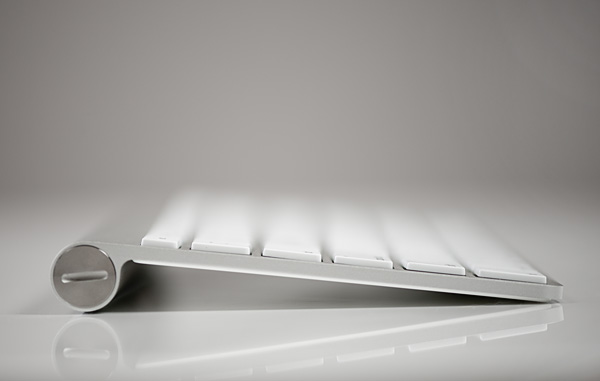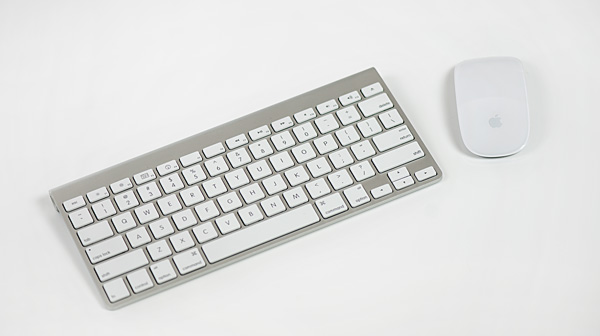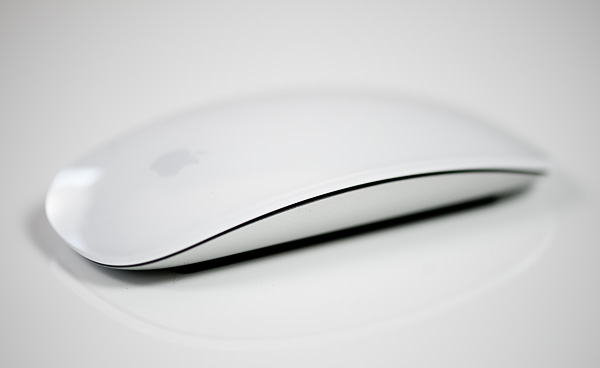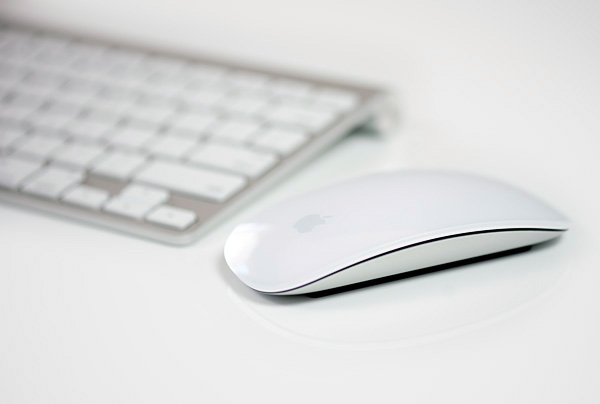The 27-inch Apple iMac Review (2011)
by Anand Lal Shimpi on May 27, 2011 2:30 AM ESTThe Peripherals
I've never been a fan of wireless peripherals - I didn't want more things to charge. Last year I finally broke down and bought a wireless mouse: Microsoft's Wireless Mobile Mouse 4000. I didn't buy it for mobility, I just liked the form factor.
The iMac comes with all wireless peripherals. In fact, if you stick with WiFi for network access, there's only a single cable you need going to the iMac: power. By default you get Apple's Wireless Keyboard and a Magic Mouse.
The Wireless Keyboard is a Bluetooth keyboard that runs off of two AA batteries. It pairs effortlessly with the iMac and I didn't encounter any issues with interference in using it. The keyboard seems to burn through batteries quicker than the mouse, perhaps that's because I type far too much or there's an issue with power management under OS X. After a week of use I'm down to 81% on a fresh pair of batteries (this is my second set).
The keyboard itself is a lot like Apple's standard aluminum keyboard, just wireless and more compact. Apple chopped off the dedicated home/end key island as well as the numeric keypad. Under OS X Cmd + Left/Right Arrow take the place of Home/End for me so part of the sacrifice isn't a problem, but the missing numeric keypad is. I do entirely too much data entry (ahem, benchmarks) to not have a dedicated numeric keypad, and for some reason Apple doesn't offer the Wireless Keyboard with one.
If you don't type tons of numbers every day however, the Wireless Keyboard is really nice. Apple had to stick a function key to the left of the control key, which is a bit bothersome (leave my control/option/cmd row alone) but it's nothing you can't get used to. The footprint is great. I have a giant desk, but I always seem to run out of desk space. The Wireless Keyboard makes it so that I can reclaim a small amount of high value desk area.
Typing feel and keyboard angle are both great - no complaints there. I'm a fan of Apple's keyboards.
Pointing devices designed in Cupertino are another story entirely. I've never liked Apple's mice. It was a big enough problem that when I first tried my Month with a Mac experience I ditched Apple's mouse. There was no way I was going to give the platform a fair shake if I had to use that thing. Since then Apple has at least enabled double clicking - the surface of the Magic Mouse is touch sensitive, click with your right finger and you get a right click. The Magic Mouse has no scroll wheel but drag your finger around on its surface and you get the best scrolling experience on a physical mouse.
The Magic Mouse is also a Bluetooth device that quickly pairs with the iMac. I noticed under Windows there's always a second or two of lag before it recognizes the mouse whereas it's useable as soon as you can see it under OS X.
My complaints about the Magic Mouse are three-fold. As I've mentioned before, the Magic Mouse doesn't have soft rubber feet that glide around on your desk. Instead you get two hard plastic strips that just seem to scrape against all surfaces. Tracking isn't a problem, but it's not a pleasant experience.
The other issue I have is the form factor itself. Microsoft's Wireless Mobile Mouse 4000 is small but it has a nice curve to it that seems to match my hand very well. The Magic Mouse on the other hand doesn't conform to any part of my body. I can lay my hand flat on it but either I'm not conditioned to do that or that's not a very comfortable way to use the mouse for long periods of a time.
Finally there's the clicking noise it makes. Modern mice seem to have a solid but more muted click, whereas the sharp click of the Magic Mouse reminds me of the past decade of Apple mice. I assume that's what Apple was going for, but Apple's market share has grown considerably in the past 10 years - it's ok to let go of some traditions.
Apple does offer the Magic Trackpad as a no-cost option. I have a love/hate relationship with the Magic Trackpad as a pointing device. Scrolling and gestures are great on it, but I prefer a normal mouse for most everything else.
















139 Comments
View All Comments
dagamer34 - Friday, May 27, 2011 - link
It's a desktop CPU, but a laptop GPU, and it really shows on page 4 when comparing the 6970M against desktop card. When you've spent $2000 on a machine with the same graphical performance as a $160 video card, that's when you REALLY know that Macs are NOT meant for gaming.That's why instead of buying an 27" iMac for gaming, I bought a 27" ACD and built a gaming PC. Same price, but PC parts (especially GPU) are upgradable, and since the computer isn't attached to the monitor, it retains it's value a LOT more.
Penti - Friday, May 27, 2011 - link
I would prefer the Dell U2711 here, as it's about 450 dollars less here in Sweden with Apples fucked up pricing tied to old exchange rate. Neither is it too fun with a 1650 dollar screen with just mini-displayport input. (Of which 25% VAT is included).Kristian Vättö - Friday, May 27, 2011 - link
Not a big deal but I thought I would add them anyway. On first page, you say 15" MBP has AMD 6770M while it really has 6750M. Scroll down to the HD part of the first page and it says the base 21.5" comes with 512GB HD, while it is a 500GB.For anyone who says I'm nitpicking, I'm not. I have written articles myself and I have made typos too. Look at the Ivy Bridge/Panther Point article's comments if you don't believe (I typoed that IB IGP will have OpenCL 10.1 :D). Like I said, it isn't a big deal but personally, I appreciate if someone points out my typos in a friendly matter.
BTW, Anand, you look like the mafia boss of SSDs in the FaceTime pic :D SSDs for every finger.
tipoo - Friday, May 27, 2011 - link
Also on the GPU page, "The entry level 21.5-inch MacBook Pro "...Now that would be an interesting product, lol.awaken688 - Friday, May 27, 2011 - link
"I've always kept displays through several upgrades, but you can't really do that with an iMac. I'm not really sure how to come to terms with that aspect of what Apple is offering here."That is the key statement. You have a nice $1000 monitor, but you have to sell it to upgrade (yeah, you can use it again, but you have a whole computer in the back). So you take depreciation on your hardware and depreciation on your monitor. Then you get another iMac and repeat. In the PC world of desktops, you get a nice monitor and only take depreciation one time on the monitor. Over 3 upgrade cycles, that can be $500-$1000 in savings over the iMac solution depending on the quality of the monitors. That is a big deal. MacBook Pros make perfect sense to me, but Apple just does not offer a desktop model that fits my needs. Mini is too slow and Mac Pro has Xeon cores which I refuse to pay for as I don't need them. I won't hold my breath for Apple to fill in my needs.
Kristian Vättö - Friday, May 27, 2011 - link
Mac Pros just have an extremely fat profit margin, nothing else. Xeon 3000-series CPUs cost as much as their Core iX counterparts. For example the W3530 used in base Mac Pro costs 294$, which is the same as what i7-930 costs. Dell sells a similarly equipped workstation for around 1500$, and yes, that includes Xeons, ECC RAM, workstation GPU (something that MP doesn't have) etc.It's obvious that iMac is Apple's flagship in consumer desktop market. They have shown zero interest towards a mid-tower though why would they? iMac is selling brilliantly.
dagamer34 - Friday, May 27, 2011 - link
At this point, Mac Pros are pretty much in dire need for a price adjustment. Even if you really do need all that power, I think buying it makes you feel silly compared to what is available in the MacBook Pros and iMacs of today. And with Thunderbolt, the biggest reason to buy a Mac Pro has disappeared (high speed i/o cards).Penti - Friday, May 27, 2011 - link
Well when they still where new, the dual processor models where priced competitively against real HP and Dell workstations which often even did cost a bit more. The problem here are two things, the single processor model is just rubbish and priced about 1000 dollars too much (a year ago or even two years ago) and that Apple never adjusts the price of a model but instead replaced them with a new one. With a new price.A single socket Mac pro shouldn't be more then a C i7 2600K for like 1200 dollars now, a extreme edition SNB would cost some additional 700 dollars, dual processor model should use something like Westmere-EX by now. 10-core (6-10C) two socket support and quad-channel memory. Why mess around with LGA2011 or LGA1366 today? They pretty much have no choice but to go real high-end or use normal desktop parts with the Mac Pro update. There are no Sandy-Bridge workstation class processors. And dual 8C Westmere-EX would end up costing something like 6000 dollars for the machine though. There's just no good workstation hardware competitively priced there to begin with right now. Right now it doesn't get better then dual Westmere 2.93GHz as the Mac Pro uses. AMD HD6970, two 8-core Westmere-EX is pretty much as far they could go today/this year and that would end up costing at least above 5000 dollars. Just leaving iMac comfortably under that as workstation. But they probably won't upgrade that until sometime after Lion any way.
KoolAidMan1 - Friday, May 27, 2011 - link
The thing is that depreciation on the iMac is much much slower than it is with PC parts. I sell my iMac and my gaming PC components at roughly the same time, and what I make back selling the old iMac is significantly higher than what I sell my PC parts for.Getting a high resale return on my old 24" iMac and using the proceeds to get a new 27" iMac with that gorgeous display was a great deal, and it actually sold me (I was skeptical too) on the idea of upgrading all-in-ones by selling the whole thing on ebay. Getting a similar return on my PC is just not possible.
tipoo - Friday, May 27, 2011 - link
Does anyone know if the GPU switching is enabled in the iMac's? They didn't mention the HD graphics on the spec page unlike the MBP's, so maybe they didn't bother with it since there is no battery. Also most of them use the HD2000 which is half as powerful as the HD3000, so maybe it didn't meet their requirements even for basic desktop work.